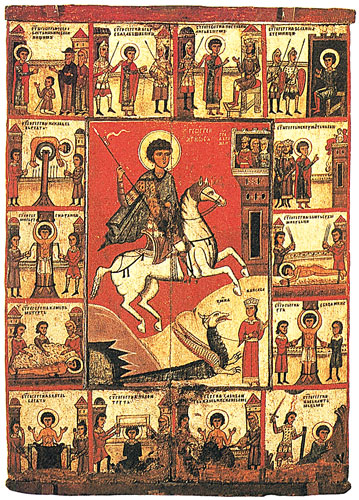A new miracle of St. George?
 First things first: His name is not St. George the Dragon Slayer. Most of the time, you will hear him called the Great Martyr St. George the Trophy-bearer, or a variation on that title. The key is that he died as a witness to his faith. As one of the hymns honoring him says:
First things first: His name is not St. George the Dragon Slayer. Most of the time, you will hear him called the Great Martyr St. George the Trophy-bearer, or a variation on that title. The key is that he died as a witness to his faith. As one of the hymns honoring him says:
You were bound for good deeds, O martyr of Christ: George; by faith you conquered the torturer's godlessness. You were offered as a sacrifice pleasing to God; thus you received the crown of victory.
Truth be told, the lede on this interesting Associated Press story gets the dragon right up top, but the story does not actually make an inaccurate reference to St. George. So with that stated, let's move on to the heart of matter -- which centers on an icon of the saint in the town of Ramla, Israel:
Christians have been flocking to this dusty Israeli town to see what locals are calling a miracle: streaks of what looks like oil mysteriously dripping down an icon of St. George at a Greek Orthodox church named for the legendary third century dragon slayer.
Worshippers said ... that the more than two dozen streaks might represent God's tears or the Christian rite of baptism. The church priest, Father Nifon, first saw the streaks while preparing for Sunday morning services, they said.
"He kissed all the icons, and when he reached that one, he took down the picture and he cleaned it," said Aida Abu el-Edam, an English teacher and longtime church member. "After 20 or 25 minutes, he looked again and he saw the oil again and said, 'This is a miracle.'"
We don't have time to discuss the sad details behind another question here: What is a Greek Orthodox Church doing in what is clearly a Palestinian community in Israel. This is a case where I think the reporter should have called it an Eastern Orthodox church and left it at that. But there are many reporters, it seems, who think that the whole of Eastern Orthodox Christianity is Greek.
The heart of this story is the phenomenon of myrrh-streaming icons and, frankly, this report does a fine job of handling that subject (while failing to mention the myrrh).
Here is the key passage, starting with another quote from Aida Abu el-Edam:
"It's a special, holy smell," she said. "It's not ordinary, like olive oil. It's something strange that comes from God."
The Greek Orthodox patriarch inspected the painting Sunday, el-Edam said, and the church has sent a sample of the oil to a laboratory.
Father Nifon said the Greek Orthodox Patriarchate had asked him not to speak publicly or to answer questions about the streaks, so that believers could draw their own conclusions.
In other words: Let the people pray and let the lab workers do their work. The church will then deal with the results.
The story contains some interesting information about the religious and even political context of these claims about the icon. I could have used a sentence or two about why St. George is so important to Arab Christians, but I understand that length is an issue for wire services.
It's appropriate, of course, to look for non-miraculous explanations for this phenomenon with icons. That leads us to this wonderful quote, from another voice drawn from the laypeople of this parish:
"People these days, they've forgot God and this is a sign to tell them, 'I'm still here,' said Edith Fanous, 31, who works for a local trucking company and said she has been attending St. George's since she was a little girl.
Fanous said she was singing in the church choir when the oil streaks appeared Sunday. She guessed as many as 1,000 visitors had been to the church since then. She dismissed the idea that the streaks could just be paint running on a hot day.
"This icon is 114 years old," she said. "It passed through so much weather, hot and cold. And now that we have air conditioning in the church it's started to melt? I don't think so."
Ah, the impact of air conditioning on the study of a 114-year-old icon. I sure hope the Associated Press does a follow-up report on this.
IMAGE: An icon on the life of the Great Martyr St. George.